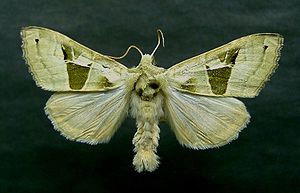Emerald Owl
| Emerald Owl | ||||||||||||
|---|---|---|---|---|---|---|---|---|---|---|---|---|

Emerald Owl ( Phlogophora scita ) |
||||||||||||
| Systematics | ||||||||||||
|
||||||||||||
| Scientific name | ||||||||||||
| Phlogophora scita | ||||||||||||
| ( Huebner , 1790) |
The emerald owl ( Phlogophora scita ) is a butterfly ( moth ) from the family of the owl butterflies (Noctuidae).
features
butterfly
The wingspan of the medium-sized butterfly is around 40 to 48 millimeters. The fore wing color of the emerald owl is usually light green. The middle field drawn in towards the inner edge is colored darker green. The area of the ring blemishes is clearly lightened, that of the kidney blemishes has the darker color of the middle field. On the indistinct outer transverse line there is a small, dark green, arrow-shaped spot in front of the wing tip. Another green, somewhat diffuse field can be seen at the inner edge of the root field. The species varies in color and the following forms are described:
- f.flavescens bobbin , with yellowish fore wings
- f.olivacea Spuler, with olive-brown fore wings.
The latter form is somewhat similar to the olive-brown color variant of the agate owl ( Phlogophora meticulosa ), which is, however, somewhat larger, has a V-shaped central field with a mostly more pronounced brownish tint and has a much more jagged forewing edge. The hind wings of the emerald owl are strikingly light. The head is provided with a thick tuft of hair, the abdomen is lightly haired.
Egg, caterpillar, pupa
The egg is cone-shaped, with a clipped tip and straight, thin longitudinal ribs. It is initially white and later turns yellowish and pink in color. It also has a dull crimson band consisting of individual spots. The yellow-green caterpillar of the emerald owl is slender, slightly thickened at the end and slightly raised on the eleventh segment. A dark line and an x-shaped drawing can be seen on the sides. The spiracles are outlined in white and black. The pupa is red-brown in color, very slender with a blunt abdomen , which has two longer hooks and several very short, small, curved bristles.
Similar species
- Agate Owl ( Phlogophora meticulosa )
Synonyms
- Habrynthis scita
distribution
The species is widespread in Central and Eastern Europe, in the Alps it rises up to 1600 meters. It is mainly to be found in the mountains and in mountain valleys and also inhabits deciduous and mixed forests .
Way of life
The nocturnal emerald owl flies from mid-June to early September and also visits artificial light sources . The caterpillars live on various fern species from August , for example on worm fern ( Dryopteris ), rib fern ( Blechnum spicant ) or bracken ( Pteridium aquilinum ). In the spring of the following year they overwinter and feed on many different plants, including violets ( Viola ), plantain ( Plantago ), hawthorn ( Crataegus ), sloe ( Prunus spinosa ), raspberry ( Rubus idaeus ) or oak ( Quercus ) . As soon as the ferns sprout, they return to them, where they live until the end of May and then pupate.
Danger
Although the species is very rare in many areas, it is only listed in category 3 (endangered) on the national red list of endangered species in Germany.
swell
Individual evidence
- ↑ a b Manfred Koch: We identify butterflies. Volume 3: Owls. 2nd, expanded edition. Neumann, Leipzig / Radebeul 1972, DNB 760072930 .
- ^ A b Walter Forster, Theodor A. Wohlfahrt: The butterflies of Central Europe. Volume 4: Owls. (Noctuidae). Franckh'sche Verlagshandlung, Stuttgart 1971, ISBN 3-440-03752-5 .
- ↑ Federal Agency for Nature Conservation (Ed.): Red List of Endangered Animals in Germany. Landwirtschaftsverlag, Münster 1998, ISBN 3-89624-110-9
literature
- Manfred Koch : We determine butterflies. Volume 3: Owls. 2nd, expanded edition. Neumann, Leipzig / Radebeul 1972, DNB 760072930 .
- Walter Forster , Theodor A. Wohlfahrt : The butterflies of Central Europe. Volume 4: Owls. (Noctuidae). Franckh'sche Verlagshandlung, Stuttgart 1971, ISBN 3-440-03752-5 .
Web links
- www.lepiforum.de Taxonomy and photos
- redist endangerment
- www.nic.funet.fi dissemination
- Phlogophora scita at Fauna Europaea